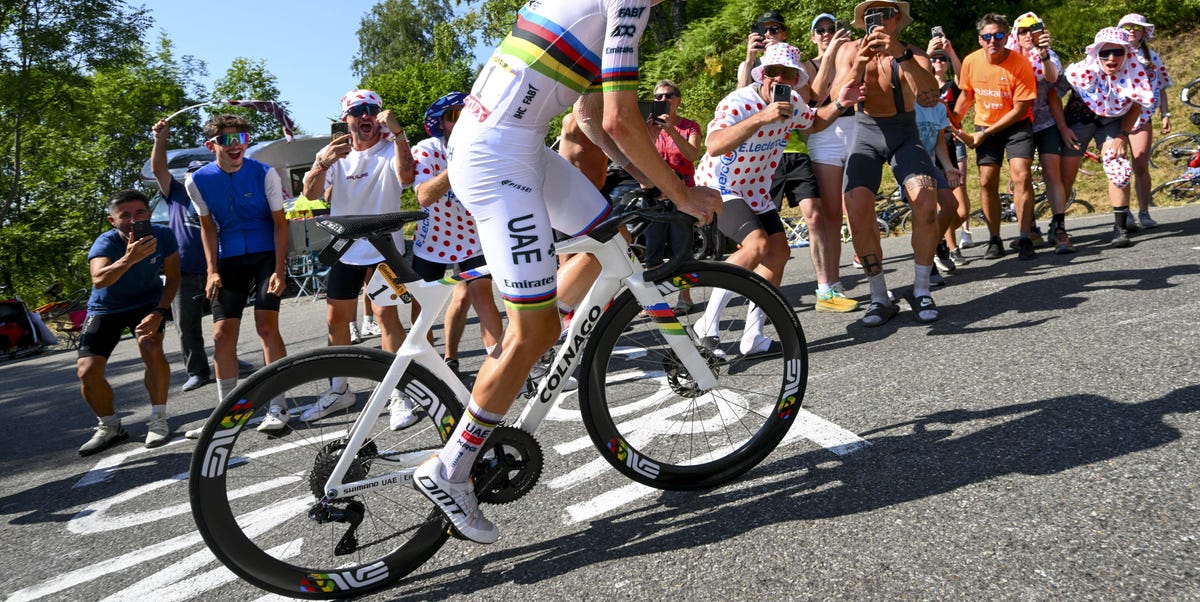One of the major equipment talking points of the 2025 Tour de France was the widespread use of aero bikes and wheels on the most challenging climbing stages.
Even teams that had both a lightweight all-rounder and a heavier aero bike used the aero-focused bike for nearly every stage and regardless of the course profile.
It felt like this was the year that, more than any other, proved what the tech pundits have been saying for years: aerodynamics matter more than weight. And as I outline below, it is a lesson that applies even if you’re not climbing as fast as the pros.
A prime example of the aero domination of the 2025 Tour was the monster stage 18 from Vif to Col de la Loze.
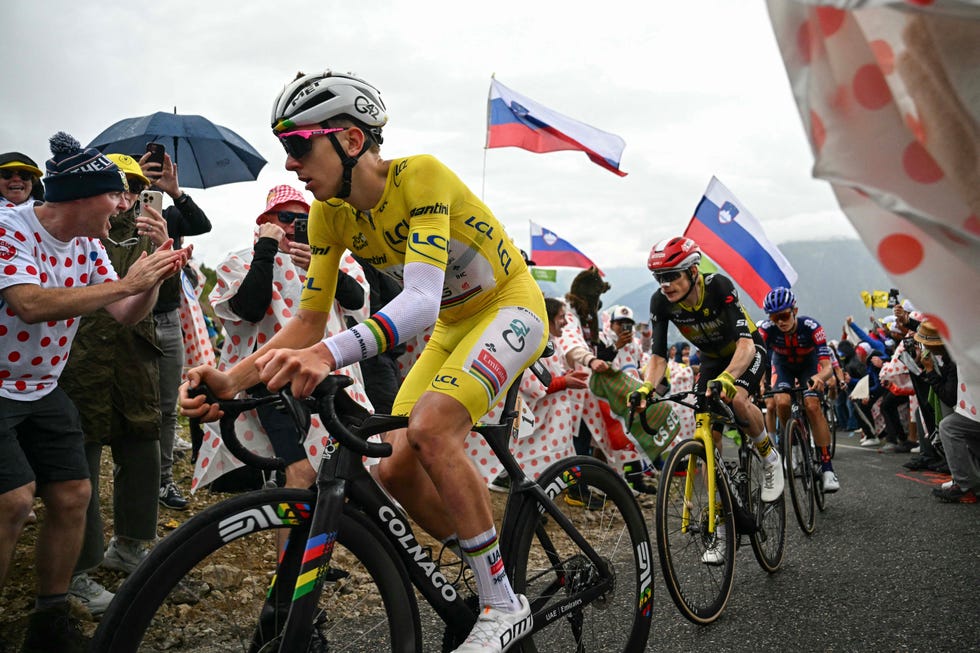 LOIC VENANCE//Getty Images
LOIC VENANCE//Getty Images
Pogacar and Vingegaard used their aero bikes for the toughest climbing stage of the Tour.
This stage featured three hors catégorie (HC) ascents in 171.5 km (106.5 miles), totaling 5,450 meters (17,880 feet) of climbing. That is a ton of climbing in just 106 miles; consequently, there weren’t many flat roads to consider.
And yet, both Tadaj Pogacar and Jonas Vingegaard were aboard their team’s aero bikes (the Colnago Y1Rs and the Cervelo S5, respectively) as they battled for the general classification. The stage was won by Jayco Alula’s Ben O’Connor riding a Giant Propel aero bike and not Giant’s lighter TCR. And all these riders used fairly deep wheels as well.
What the heck?
Not too many years ago, a stage like this would have seen almost all riders on their “climbing” bikes with minimal-depth wheels. The thinking at the time was that while aero bikes were faster on flatter terrain, you always want to be on the lightest bike for the climbs.
Their choice is between two bikes that weigh about the same, but one is more aerodynamic.
Now, “The thinking” at the time was, like many things in professional road cycling, heavily rooted in traditionalism and less so on actual testing and data.
For a long time—like decades—there have been smart people trying to tell us that the math and science suggest that aerodynamics is more important than weight, even on climbs and especially if you’re as fast as a pro.
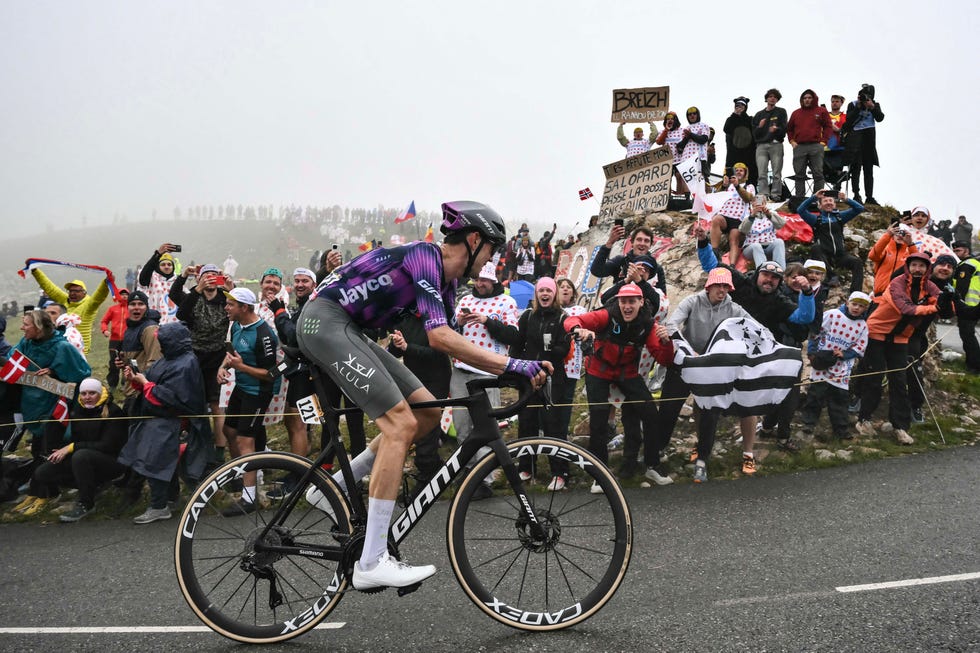 MARCO BERTORELLO//Getty Images
MARCO BERTORELLO//Getty Images
Even on the biggest climbing stage of the 2025 Tour, it was all about aero equipment.
If you don’t isolate the climb and consider the whole ride, aerodynamic gains can far outstrip the benefits of less weight, not just for climbing speed, but also for conserving energy on the way to the climb and gaining time on the descents.
It seems we’ve reached the point where traditionalist instincts are being replaced by science-based information. This is probably because teams, especially the big-budget super teams, have become more advanced and data-driven. Additionally, the older generation —not just riders, but also mechanics, directeur sportifs, and other team staff—that clings to traditionalist thinking is aging out of cycling and is superseded by a newer generation that is more accustomed to aerodynamic equipment and more open to rigorously researched data.
But there is one other important thing to consider that helps explain why aero equipment is dominating professional races like the Tour. It is the UCI’s 6.8kg (14.99 lb.) bicycle weight limit.
Aero equipment is lighter than ever, and increasingly, teams’ aero bikes (especially smaller frames for shorter riders) are approaching or meeting the 6.8kg limit. To be fair, the less aero all-arounder bikes are lighter than ever, too. But they’re so light that mechanics must add weight to them to bring them up to the 6.8kg limit.
The choice, for the pros, is not between a lighter and less aero all-arounder, and a heavier and more aero bike. Their choice is between two bikes that weigh about the same, but one is more aerodynamic. And in that case, aero will always win.
Aero equipment is lighter than ever, and increasingly, teams’ aero bikes are approaching 6.8kg
And for additional context, both the Colnago Y1Rs and Cervelo S5 take advantage of the UCI’s recently relaxed aero rules—meaning brands can make their frames more slippery than the old 3:1 regulation allowed—which means that the newest and best aero bikes in the peloton are more aerodynamically efficient than ever yet still approaching the 6.8Kg weight minimum.
Another factor that helps us understand why aero equipment is taking over is the sheer speed of the pros.
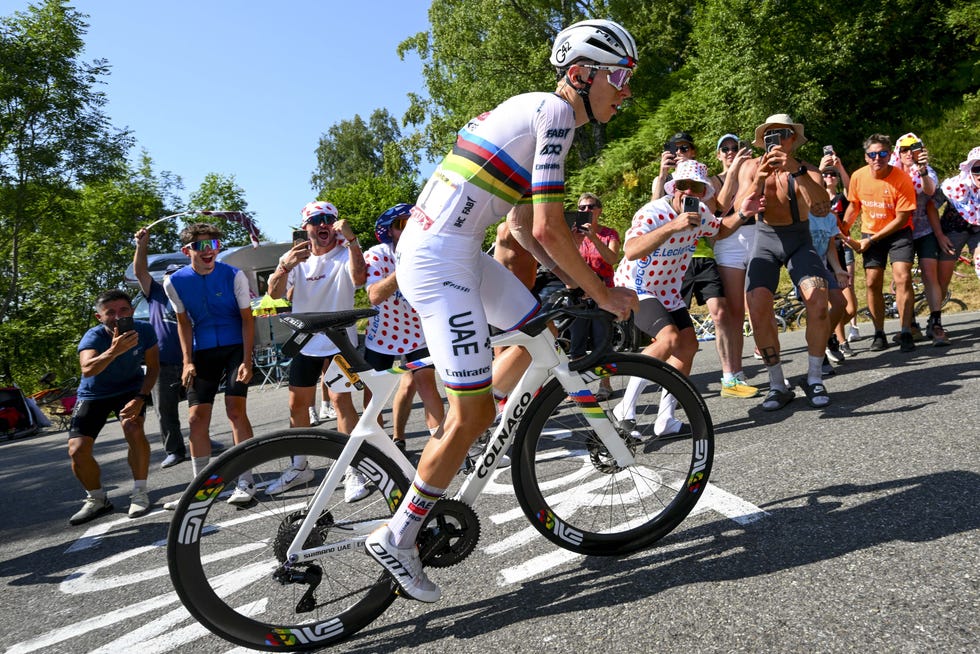 POOL VINCENT KALUT//Getty Images
POOL VINCENT KALUT//Getty Images
Pogi used his aero bike to win atop Hautacam on Stage 12.
On the Hautacam (13.5 km at 7.8 percent), the final climb of Stage 12, Tadej Pogačar rode at an estimated 6.7 watts per kilogram for about 35 minutes with an average speed of 23 km/h (14.3 mph) as he soloed to victory. And for context, he had crossed 167 KM and three significant climbs (a category 1, 2, and 4) before reaching the base of the Hautacam.
Pogacar’s average speed for the whole of stage 12 was 41.5 km/h (25.8 mph). His average speed for the entire Tour de France was almost 43 km/h (26.7 mph).
With their aero bikes weighing about the same as all-arounders and the raw speed of today’s pros, it’s no wonder aero bikes—and aero equipment, period—dominate. And there’s nothing on the horizon that will impede this trend. Riders are only getting faster, aero equipment will continue to get lighter, and bike brands will continue to find ways to exploit the UCI’s new aero rules.
But what about the rest of us? Should we look to the pros to help guide our equipment choices when we can’t climb as fast and when our bikes aren’t subject to the UCI’s weight minimums?
Maybe?
If raw speed and efficiency are your primary concerns, then, yes, there are lessons to be learned from the equipment riders use in the Tour. Even if you’re far slower than the pros, improving your aerodynamic profile can result in significant gains.
However, since the UCI’s weight restriction does not affect our equipment, we might notice a larger weight difference between our climbing bike and our aero bike than the pros face, which could alter the calculations. Even so, a significant weight difference between an aero bike and a climbing bike is probably less impactful than you might think.
 Matt Phillips
Matt Phillips
I would be less than 1 percent slower up Hautacam on a 2.2-pound heavier bike.
Even a 1,000-gram (2.2-pound) heavier bike would only make a few seconds’ difference on a long climb. To illustrate, I used the numbers from my climb up Hautacam in early July 2025. I tackled this climb on an Ari Suncrest, a lightweight all-arounder with minimal aerodynamic frame shaping.
Based on my climb performance, I would have been 48 seconds (less than one percent) slower up Hautacam if I had ridden a more aerodynamic bike that was 1,000 grams/2.2 pounds heavier. However, that is without accounting for any benefits a more aerodynamic frame might provide.
But as my climb up Hautacam illustrates, it is still absolutely true that if you view a long, steep climb in isolation, a lighter bike will often be faster to the top than a heavier aero bike.
SwissSide is one of the most aero-focused brands in the bike industry. While they make wheels—they’re the wheel sponsor of the Decathlon AG2R La Mondiale team—they also do a lot of research and are aerodynamic consultants for many brands in the industry.
There must be 14,764 feet of climbing every 62 miles before weight is more critical than aero
To address the weight versus aero debate, they modeled different bike scenarios on stage 11 of the 2021 Tour de France. This stage featured four categorized climbs before reaching the final ascent of the HC Mont Ventoux (15.7 km at 8.8 percent). Notably, though, this stage did not conclude at the summit but featured a descent down Ventoux to the finish.
And in their calculations, a solo rider—assuming Tour-level speed and power—would be 19 seconds faster up the Ventoux climb on a 1,000-gram lighter bike. However, for the whole 199km stage, the rider on the 1,000 grams heavier, but more aerodynamic, bike would be 3 minutes and 16 seconds faster.
In a tidy summary, SwissSide proclaims that, for professional riders, the average gradient for the entire ride needs to be 7.5 percent—meaning 7500 meters / 24,000 feet of climbing per 100 km / 62 miles—before weight becomes more important than aerodynamics.
For us non-pros, the gradient drops to 4.5 percent (4500 meters / 14,764 feet of climbing per 100 km / 62 miles) before weight becomes more critical than aerodynamics.
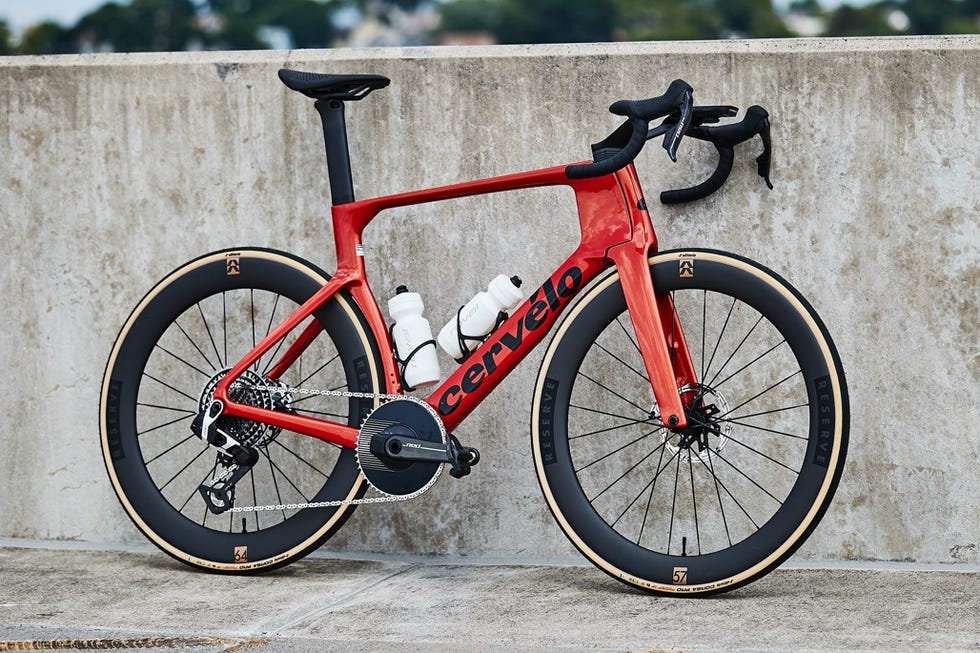 Trevor Raab
Trevor Raab
Even on rides with huge climbs, non-pros like you and me would be faster overall on a more aerodynamic bike like the Cervelo S5.
That means, even for us, a more aerodynamic bike would be faster overall than a lighter bike on the monster stage 18 of this year’s Tour de France.
So, yes, aerodynamics matters a lot, and even if we aren’t restricted by the UCI’s 6.8 kg bike weight limit. But you don’t need to buy a new frame or wheels to improve your aerodynamic profile meaningfully. You can realize tremendous gains by getting a bike fit that prioritizes aerodynamics, and by wearing a more aerodynamic helmet and clothing. You can also boost efficiency by optimizing your tires and chain lube.
Related Story
More importantly, though, do you care? Is being a little faster here or there all that matters to you? A benefit of being a civilian rider is that we don’t have sponsor obligations, so we can choose to ride any equipment we want for any reason, and we only need to focus on our enjoyment.
I watch bike racing: I am in awe of the pros and appreciate the hard work and innovation that goes into making the racing bikes that meet their needs. Even so, I enjoy riding a bike custom-built to my needs and specifications by a skilled, independent craftsperson more than riding the latest aerodynamically optimized hyperbike made for pros by a big brand.
Related Story
But if speed mattered to me most, I’d take the lessons from the pros and listen to what the smart people have been trying to tell us for a very long time: If you want to ride as fast as possible, stop focusing on weight and maximize aerodynamics.

A gear editor for his entire career, Matt’s journey to becoming a leading cycling tech journalist started in 1995, and he’s been at it ever since; likely riding more cycling equipment than anyone on the planet along the way. Previous to his time with Bicycling, Matt worked in bike shops as a service manager, mechanic, and sales person. Based in Durango, Colorado, he enjoys riding and testing any and all kinds of bikes, so you’re just as likely to see him on a road bike dressed in Lycra at a Tuesday night worlds ride as you are to find him dressed in a full face helmet and pads riding a bike park on an enduro bike. He doesn’t race often, but he’s game for anything; having entered road races, criteriums, trials competitions, dual slalom, downhill races, enduros, stage races, short track, time trials, and gran fondos. Next up on his to-do list: a multi day bikepacking trip, and an e-bike race.
